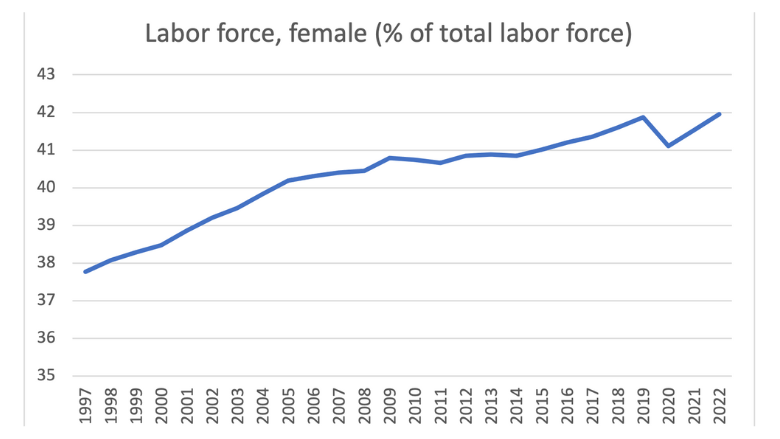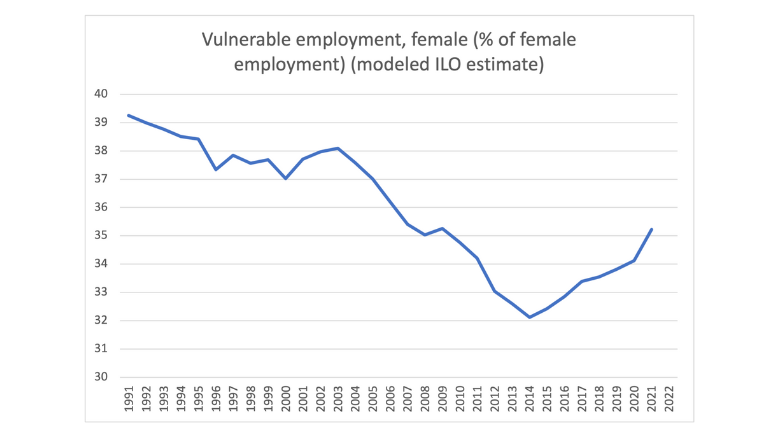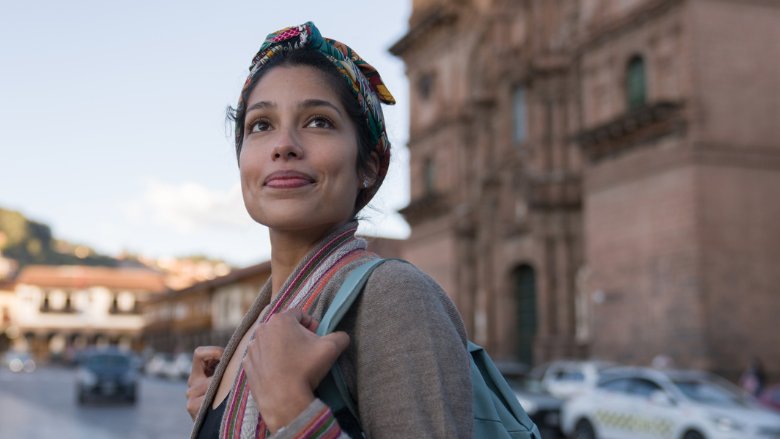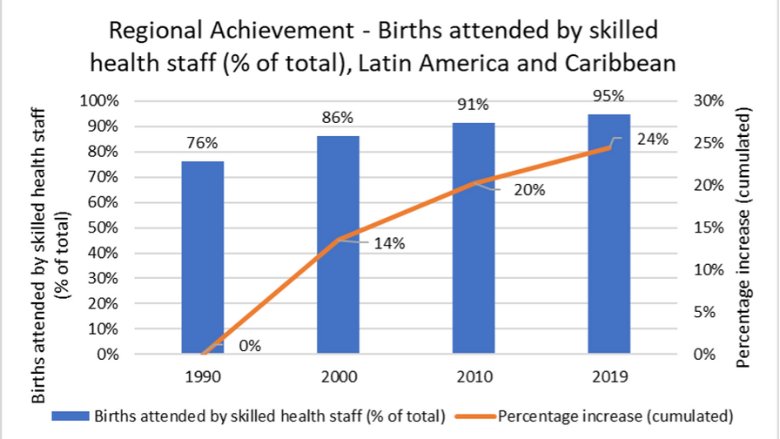Key Achievements
- 24 million women benefited from Brazil’s Bolsa Familia program in the first seven years of implementation. 1
- 25 percent increase in Brazilian women’s employment and 50 percent increase for Afro-Brazilian women post-Bolsa Familia project between 2011 and 2021. 2
- 86 percent reduction in number of HIV-infected infants born to HIV-infected mothers in Jamaica between 2008 and 2013. 3
- 24-fold increase in communities providing women judicial and social services in the Brazilian state of Amazonas. 4
- 100 percent of Ministry of Women staff trained in prevention of gender-based violence in Peru, 2018-2019. 5
- 33 percent increase in pregnant women with a risk evaluation completed before the 15th week of pregnancy in the Dominican Republic. 6
Challenge
Persistent Inequality across Borders and Sectors
Despite some development gains, outcomes in education, economic inclusion and endowments, and agency are significantly worse for women in LAC than for men. Gender imbalance represents a serious development gap in the region: in 2018, women accounted for two thirds of the region’s population not in employment, education, or training (NEET). A lack of gender-oriented health and educational policies and interventions can exacerbate adolescent fertility rate and undermine economic opportunities; LAC has the second-highest adolescent fertility rate of all regions. Poor educational outcomes are reflected in lack of economic opportunities: in almost all countries, a higher proportion of women work in the informal sector, and women spend as much as 30 percent of their daily time on unpaid domestic work and care activities,6 at least twice as much time as men. Women in LAC countries are 17 percent more likely than men to have vulnerable jobs and 20 percent less likely to have a bank account,7 even as the World Bank’s Gender Innovation Lab for the region (LACGIL) finds that in some countries boys are less likely than girls to enroll and remain enrolled in secondary and post-secondary education. Violence against women affects one in three women in the region, and this also impacts economic opportunities: the cost of violence against women is estimated to be between 1.6 and 6.4 percent of gross domestic product (GDP) of LAC countries.8 Progress on gender equality is also uneven across the region. For Indigenous, Afrodescendant, and rural women, all these challenges are significantly worse. Indigenous girls achieve persistently lower outcomes in education and literacy compared to their non-Indigenous peers, and Indigenous girls 15-19 years are up to 2.5 times more likely to become pregnant. Across the region, women in these groups typically face maternal mortality rates that are twice or three times the national average. Addressing the complexity of these challenges requires a regional and trans-sectoral approach.
Approach
Regional Strategies, Local Implementation
The World Bank’s approach to tackling these challenges has been informed by the World Bank Group Gender Strategy (FY16-23): Gender Equality, Poverty Reduction and Inclusive Growth, which identifies inclusion not as an end in and of itself, but as critical to development effectiveness. At the center of this agenda is the achievement of gender equality and empowerment of all women and girls. In the LAC region, the World Bank’s Regional Gender Action Plan (2021-2025) is aimed at guiding the design and implementation of solutions to narrow critical gender gaps at the country level. It prescribes a systematic approach to support the design and implementation of interventions that meaningfully reduce gender gaps, and includes a focus on the impact of knowledge products on the design of gender tagged operations. 
Results
Establishing the Foundations for Equality
Endowments in the areas of financial inclusion, land rights, and education are a critical focus for the LAC Gender Action Plan. In Mexico, the Savings and Credit Consolidation and Financial Inclusion Project, supported by World Bank financing of $100 million, extended financial inclusion—essential for reducing poverty and boosting prosperity—in a country where about 71 million people lacked access to formal financial services. By project close in 2017, savings and credit entities had extended their membership by 3.4 million people, of whom 59 percent were women, and nearly 2 million people—90 percent of them women—received financial education 8. In Honduras, the PATH II Program registered about 90,000 urban and rural households, with more than 50,000 new land titles awarded, 48 percent of which went to a female head of household9. Finally, the World Bank’s LAC Education Unit (HLCED) is managing 19 projects, equivalent to $2.4 billion. In Uruguay, building on evidence from impact evaluations conducted by the LACGIL, a national work-study program significantly improved the school-to-work transition for young girls and boys, with a focus on providing high-quality jobs to enable human capital accumulation through education. 10

The empowerment of women depends on their access to economic opportunity. For women entrepreneurs in LAC, access to finance is perhaps their most critical issue. The Women Entrepreneurs Finance Initiative (We-Fi) is a groundbreaking partnership between the World Bank and other multilateral development banks (MDBs) that aims to unlock financing for women-led businesses in developing countries. Fourteen percent of We-Fi’s allocations have been in LAC—the second highest after the Africa region. Support for the creation of jobs for women in small, medium, and micro-enterprises (SMMEs) is equally important. In Haiti, the World Bank’s Private Sector Jobs and Economic Transformation Project encourages labor demand by supporting such businesses. The project aims to foster economic recovery and create sustainable and resilient jobs, impacting 4,000 businesses, with an emphasis on firms owned by women. 12 Key outcomes include increased resilience for 51,000 jobs and the creation of approximately 10,000 jobs. The project will also provide improved business development services and greater access to financial resources. 13
In the area of gender-based violence (GBV), the World Bank has been supporting governments in the region through policy interventions that take a critical first step toward widespread prevention programs. In Peru, where one in three women is likely to experience physical or sexual violence from an intimate partner in her lifetime, the Minister of Economy and Finance requested World Bank support to deepen understanding of the impact of the government’s response to this epidemic of violence. The resulting study found that while Peru had doubled its investment to address GBV, only 20 percent of the investment went toward prevention. The government has used the study as a key input for design of a multisectoral strategy to maximize public spending on addressing GBV and to establish the country’s first ever results-based GBV budgeting program14. In Chile, the World Bank supported the development of a roadmap to create an integrated case management platform for GBV. The roadmap has led to strengthened training for first responders, an improved hotline for women experiencing violence, and a draft law that will allow follow-up on cases of violence against women across institutions, improve service delivery, and provide alerts in high-risk cases. 15
The economic inclusion of Indigenous, Afrodescendant, and rural women is a critical development goal in a region where outcomes for these women are appreciably worse than those for the general population in almost every area, including education and other endowments, as well as GBV. In Mexico, the Dedicated Grant Mechanism (DGM) for Indigenous People and Local Communities (IPLCs) approved 51 sustainable natural resource management (NRM) projects led by IPLCs, focused on creating female role models who could serve as technical allies for income-generating subprojects. Seventy-nine percent of the staff supported and hired through this project are women. Under the DGM, a total of 192 participating financial intermediaries (PFIs) provided 174,000 credits to 140,000 rural producers and SMMEs, with an average loan size of $1,850; 81 percent of recipients are women, dramatically exceeding the project target of 60 percent. 16
A Massive Cash Transfer Program Reduces Inequality in Brazil Brazil’s Bolsa Familia (BFP) conditional cash transfer program was aimed at reducing the country’s extremely high level of income inequality and improving human development outcomes, such as education achievement and nutrition. The World Bank supported the program since its inception in 2003, helping build the capacity of its implementing agency providing training and technical assistance to municipalities, supporting the creation of state-and-municipality-level delivery units, and improving its interface with public agencies to facilitate the selection of beneficiaries. BFP was enormously successful, benefiting nearly 47 million people from 2011 to 2021, of which nearly 24 million were women, and resulting in a 58 percent decline in extreme poverty and a 41 percent reduction in inequality. Bolsa Familia was one of the world’s best-targeted programs of its kind; 94 percent of its funds reached the poorest 40 percent of the population. Women represent about 89 percent of direct cash transfer recipients, as most transfer payments were made directly to the mothers of beneficiary children. BFP’s success sparked adaptations in 19 countries including Chile and Mexico. The program was expanded to reach 14 million families when the COVID-19 pandemic hit, as an early response to the economic shock. "Bolsa Familia has been a marvelous thing for me and my family,” said Dinalva Pereira de Moura, from the Varjão favela in the Federal District. “My children know that when we receive the money, they will have more to eat, and that makes them happier. And they don't skip school, because they know that the money depends on their going." |
Partnerships
Partnering with the IDB for Access to Justice in Brazil
Beginning in 2015, the World Bank and the Inter-American Development Bank (IDB) supported the government of Amazonas province in the provision of judicial and social services to women. The Amazonas: Modernizing Public-Sector Management, Citizen Security, and Gender Policies Development Policy Loan (DPL) was designed to complement and extend the IDB’s work in Amazonas, with the IDB focusing on the legal and regulatory aspects of the reforms and the World Bank on implementation policies Under the GBV component of the program, efficiency and transparency in the provision of citizen security services was improved, working to improve integration among the different entities operating in this sector, and to promote policies that improve women’s access to justice and social assistance services. This partnership, among other outcomes, led to a 24-fold increase in communities providing women with judicial and social services. 20
Looking ahead
Scaling Up Regional Progress
The World Bank is committed to supporting innovation and collective action that can lead to the achievement of three main objectives: elevating human capital and ending GBV; expanding and enabling economic opportunities; and engaging women as leaders. The LAC Gender Action Plan will continue to scale up progress for women in the region through World Bank operations, policy dialogue, technical assistance, and analytical work.

